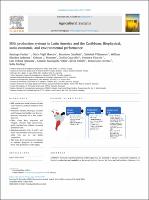Milk production systems in Latin America and the Caribbean: Biophysical, socio-economic, and environmental performance.

View/
Date
2024Author
Fariña, Santiago
Vigil Moreno, Osiris
Candioti, Francisco
Villanueva, Cristóbal
Sánchez Ledezma, William
Moscoso, Cristian J.
Cajarville, Cecilia
Charlón, Verónica
Urbina Abaunza, Luis
Guacapiña Viteri, Antonio
Chirife, Silvia
Herrera, Domiciano
Stirling, Sofía
Sustainable development goals
ODS 8 - Trabajo decente y crecimiento económico
ODS 10 - Reducción de las desigualdades
ODS 11 - Ciudades y comunidades sostenibles
ODS 12 - Producción y consumo responsables
Type
Artículo
Metadata
Show full item recordAbstract
The Latin America-Caribbean (LAC) region has the potential to pursue a sustainable expansion of
livestock production and capitalise on the growing global demand for dairy and beef products. However, it is
This study aimed to compare the milk production systems of nine countries of the region according
to their major biophysical, socio-economic, and environmental performance indicators.
A panel of experts from different research organisations of each of the 9 countries defined the modal
milk production system based on national reports and statistics. Each system was modelled by means of a whole farm model, and 22 performance indicators were estimated as a result. The countries were classified in groups by cluster and principal component analyses and the sources of similarities and differences among them were described using the information provided by the 22 indicators evaluated.
A pattern comprising three groups of countries was found. Honduras, Nicaragua, Panama, Paraguay, and Ecuador formed a group with the largest room for improvement in terms of productivity (milk and beef) and profit, associated with low yields and low quality of home-grown forage consumption and poor herd efficiency. However, they attained a competitive cost of production in global terms. The group of Uruguay, Argentina, and Costa Rica achieved a higher production per hectare and larger scale of operations while also maintaining a competitive cost of production. Chile showed a unique suite of indicators, with even higher productivity and profit overall. Higher productivity and profit indicators were related to increased output and income per unit of workforce or family unit as well as to lower emissions of CH4 per unit of product. Emissions per hectare naturally increased with productivity although below the levels of more intensified overseas countries where environmental regulations are applied. The findings of this study determine pathways for regional or national technology transfer and innovation programs and public policies in LAC to boost milk production with a systems approach and consideration of economic, social and environmental impact.
Keywords
Zonas rurales||rural areas||zona rural||zone rurale, Desarrollo sostenible||sustainable development||desenvolvimento sustentável||développement durable, Sostenibilidad||sustainability||sustentabilidade||durabilité, Leche||milk||leite||lait, Cooperación internacional||international cooperation||cooperação internacional||coopération internationale, Ganadería||animal husbandry||criação animal||élevage,
Delegation
Sede Central
Publisher
Elsevier Ltd.
Is part of
Agricultural Systems Journal
Status
restrictedAccess
xmlui.dri2xhtml.METS-1.0.item-uri-link
https://doi.org/10.1016/j.agsy.2024.103987

